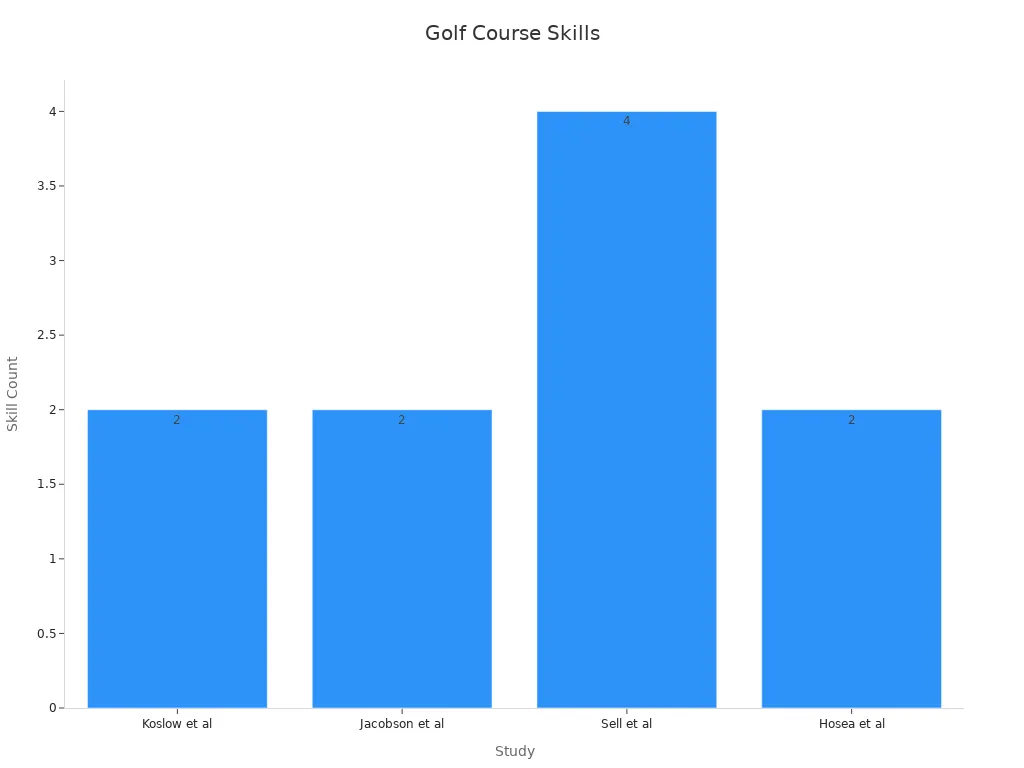
Effective Tips for Managing Golf Course Employees
Share
Managing golf course employees effectively plays a vital role in creating a thriving workplace. Strong management practices can boost employee performance, improve retention, and foster a positive culture. For example, golf courses with effective management often achieve an 86% member retention rate, surpassing the industry benchmark of 75-85%. Additionally, these courses report higher member satisfaction scores of 90%, compared to the average of 75-80%. By addressing challenges like seasonal staffing and diverse roles, you can ensure your team operates efficiently and delivers exceptional service.
Key Takeaways
Teego AI Golf Tee Time Bot
The only 24/7 automated tee time booking system that directly integrates with GolfNow, guaranteeing zero missed bookings.
Get A Quote Now- Pick the right workers by focusing on key skills. Look for teamwork, good communication, and problem-solving to build a strong group.
- Use a clear onboarding plan. Teach new workers about your golf course's goals and give them training to do well from the start.
- Create a happy workplace with open talks. Team meetings and fun activities help everyone work better together.
- Give chances to learn and grow. Training and skill programs keep workers interested and working hard.
- Show thanks for good work. Simple rewards and praise make workers feel valued and stay longer.
Building a Strong Foundation
Hiring the Right Golf Course Employees
Identifying essential skills and traits for golf course roles.
Finding the right people for your golf course starts with identifying the skills and traits that lead to success. Research highlights the importance of balance, flexibility, and consistency in roles that require physical activity, such as groundskeeping or caddying. For customer-facing positions, traits like strong communication skills, patience, and problem-solving abilities are essential. The table below outlines key findings from studies on skills and traits that correlate with high performance in golf-related roles:
|
Study |
Findings |
Skills/Traits Correlated |
|---|---|---|
|
Koslow et al |
Examined COG motion in skilled golfers |
Balance, club head speed |
|
Jacobson et al |
Correlated skill level with weight shifting |
Consistency of weight shifting, swing tempo |
|
Sell et al |
Compared proficiency groups |
Balance, hip strength, torso strength, flexibility |
|
Hosea et al |
Analyzed energy transfer in professionals |
Efficient energy transfer, balance during swing |

By focusing on these skills and traits during the hiring process, you can build a team that excels in their roles and contributes to the overall success of your golf course.
Conducting thorough interviews and background checks.
Interviews and background checks are critical steps in hiring golf course employees. During interviews, ask questions that reveal a candidate’s ability to handle real-world scenarios. For example, you might ask how they would manage a difficult customer or prioritize tasks during a busy day. Background checks ensure that candidates have the necessary qualifications and a history of reliability. These steps help you avoid costly hiring mistakes and ensure your team is dependable and skilled.
Onboarding and Training New Employees
Creating a structured onboarding process.
A structured onboarding process sets the tone for new employees. Start by introducing them to your golf course’s mission, values, and expectations. Provide a clear schedule for their first week, including time for shadowing experienced staff. This approach helps new hires feel welcomed and prepared to contribute from day one. A solid onboarding process also reduces turnover by fostering a sense of belonging.
Providing role-specific training and setting clear expectations.
Role-specific training ensures that employees gain the skills they need quickly. Studies show that tailored training programs focusing on balance and skill levels lead to faster skill acquisition and improved performance. For example, teaching groundskeepers how to use specialized equipment or training pro shop staff on customer service techniques can enhance efficiency. Always set clear expectations for each role, so employees understand their responsibilities and performance standards.
A strong foundation in hiring and training not only improves employee performance but also enhances operational success. By focusing on these areas, you can create a team that delivers exceptional service and contributes to a thriving golf course.
Creating a Motivating Work Environment

Fostering a Positive Culture for Golf Course Employees
Encouraging open communication and collaboration.
Open communication fosters trust and teamwork among golf course employees. Regular team meetings provide a platform for sharing updates, addressing concerns, and brainstorming ideas. Surveys conducted in private clubs reveal that employees value opportunities to voice their opinions about performance reviews, training, and workplace relationships. This feedback helps managers identify areas for improvement and boosts morale.
Collaboration thrives when employees feel heard and respected. Team-building events, such as friendly golf tournaments or staff outings, encourage camaraderie and the free flow of ideas. These activities not only improve morale but also lead to innovative solutions for workplace challenges. Prioritizing communication and collaboration creates a motivated workforce that delivers exceptional service.
Promoting respect and inclusivity among staff.
A culture of respect and inclusivity strengthens employee relationships and reduces turnover. Studies highlight the success of Laurel Lake Country Club, where inclusivity led to dedicated staff and lower attrition rates. Simple actions, like recognizing diverse perspectives and treating everyone fairly, build trust and goodwill.
Inclusivity also enhances job satisfaction. Employees who feel valued are more likely to stay committed to their roles. By promoting respect and inclusivity, you can create a supportive environment where employees thrive.
Cross-Training and Growth Opportunities
Teaching employees multiple roles to increase flexibility.
Cross-training equips employees with diverse skills, making them more adaptable. For example, teaching a groundskeeper basic customer service skills allows them to assist in the pro shop during busy periods. This flexibility ensures smooth operations, even during unforeseen challenges.
Cross-training also boosts engagement and productivity. Employees appreciate opportunities to learn new skills, which keeps them motivated and invested in their roles. A well-rounded team can handle various tasks efficiently, contributing to the overall success of the golf course.
Offering professional development programs and promotions.
Professional development programs enhance employee satisfaction and retention. Continuous education, such as specialized courses or certifications, sharpens skills and opens doors for career advancement. Organizations like the PGA and LPGA offer training programs that elevate careers in the golf industry.
Providing growth opportunities also attracts talent. Leadership training, mentorship programs, and promotions show employees that their contributions are valued. Highlighting these opportunities makes roles more appealing and helps retain skilled staff. A focus on development ensures that your team remains motivated and committed to excellence.
Enhancing Employee Performance

Ongoing Training and Development
Scheduling regular training sessions to improve skills.
Regular training sessions are essential for improving employee skills and maintaining high standards. These sessions help your team adapt to changing labor dynamics, such as rising wages and evolving employee expectations. They also ensure that your staff understands the latest maintenance practices, aligning their work with industry standards and golfer needs.
- Training reduces mistakes and enhances operational efficiency.
- Employees gain confidence in their roles, leading to better customer satisfaction.
- Superintendents emphasize that quality training fosters excellence in service.
For example, Edward Fischer trains employees to identify potential course issues, improving their awareness and problem-solving abilities. Scheduling periodic training sessions ensures your team stays sharp and motivated.
Keeping employees updated on industry trends and tools.
Keeping your team informed about industry trends and tools is vital for staying competitive. Training programs can introduce new technologies, such as advanced turf management equipment or customer service software. These updates not only improve efficiency but also boost employee morale. Motivated workers feel valued and are more likely to stay committed to their roles.
Communication and Feedback
Holding regular team meetings to share updates and feedback.
Team meetings create opportunities for open communication. Use these sessions to share updates, address concerns, and provide feedback. Research shows that regular meetings close communication gaps between supervisors and employees, fostering a collaborative environment. These discussions also align your team with organizational goals, ensuring everyone works toward the same objectives.
Encouraging employees to voice concerns and ideas.
Encourage your team to share their thoughts and ideas. Employees who feel heard are more engaged and productive. Create a safe space for them to voice concerns without fear of judgment. This approach builds trust and strengthens relationships, leading to a more cohesive team.
Performance Evaluation
Conducting regular performance reviews.
Performance reviews are a powerful tool for improving productivity. Set clear goals and expectations before evaluating your team. Written evaluations based on predetermined criteria provide a fair assessment of each employee’s performance. Discuss these reviews with your staff to identify areas for improvement and set future goals.
Offering constructive feedback and actionable advice.
Constructive feedback helps employees grow. Focus on specific behaviors and provide actionable advice for improvement. For example, if an employee struggles with time management, suggest strategies like prioritizing tasks or using scheduling tools. Effective feedback not only boosts performance but also enhances job satisfaction.
Retention Strategies for Golf Course Employees
Recognizing and Rewarding Employees
Implementing employee recognition programs.
Employee recognition programs play a vital role in boosting morale and reducing turnover. When you acknowledge your team’s contributions, you foster loyalty and commitment. Simple gestures, such as celebrating milestones or highlighting achievements during team meetings, can make employees feel valued. Recognizing specific accomplishments, like exceptional customer service or innovative problem-solving, encourages staff to stay engaged and motivated. Employees who feel appreciated are more likely to remain with your golf course, contributing to a stable and productive workforce.
Offering incentives for outstanding performance.
Incentive programs can drive measurable improvements in employee performance. High achievers often respond positively to bonus pay or other rewards tied to their success. For example, offering gift cards or extra paid time off for meeting performance goals creates a win-win situation. Employees feel motivated to excel, while your golf course benefits from enhanced productivity and service quality. Linking incentives to clear performance metrics ensures fairness and inspires your team to consistently deliver their best.
Providing Competitive Benefits
Offering health insurance, retirement plans, and other perks.
Providing comprehensive benefits packages attracts and retains skilled golf course employees. Health insurance, retirement plans, and mental health support show your team that you care about their well-being. These perks enhance job satisfaction and morale, which directly impact productivity. For example, offering family-friendly programs helps employees manage personal obligations, allowing them to focus on their roles. Competitive benefits not only improve retention rates but also create a positive work environment that supports long-term success.
Ensuring fair and competitive wages.
Fair wages are essential for maintaining a motivated workforce. Offering pay above the minimum wage helps you attract qualified candidates and reduce turnover. Employees who feel fairly compensated are more likely to stay committed to their roles. Balancing increased labor costs with operational efficiency, such as adopting technology like the Teego AI Golf Tee Time Bot, can help you maintain profitability while providing competitive pay. This approach ensures your golf course remains both efficient and employee-focused.
Supporting Work-Life Balance
Offering flexible scheduling options.
Flexible scheduling options improve work-life balance and reduce burnout. Flextime, compressed workweeks, and job sharing allow employees to tailor their schedules to their needs. For example, compressed workweeks give staff longer weekends, boosting morale and satisfaction. These arrangements not only enhance employee retention but also create a more adaptable and resilient team. By prioritizing flexibility, you show your employees that their personal lives matter, fostering loyalty and commitment.
Encouraging time off to prevent burnout.
Encouraging employees to take time off is crucial for maintaining their well-being. Burnout can lead to decreased productivity and higher turnover rates. Offering paid vacation days or mental health breaks helps your team recharge and return to work with renewed energy. A supportive policy that prioritizes rest and recovery ensures your golf course employees remain engaged and effective in their roles.
Effective management of golf course employees drives workplace culture, performance, and retention. Small, consistent changes, like expressing gratitude or conducting meaningful performance reviews, can transform your team’s engagement and productivity. For example:
- Gratitude enhances employee performance and workplace culture, as shown in surveys of over 1 million employees.
- Constructive feedback during reviews aligns employees with organizational goals and improves communication.
These strategies, combined with clear communication and growth opportunities, create a thriving environment. A 5% increase in retention can boost customer satisfaction by up to 95%, proving that investing in your team ensures long-term success.
FAQ
How can I improve communication with my golf course employees?
Tip: Schedule regular team meetings and one-on-one check-ins. Use these opportunities to share updates, listen to concerns, and provide feedback. Encourage open dialogue by creating a safe space where employees feel comfortable sharing their thoughts.
What are the best ways to motivate golf course employees?
- Recognize achievements through awards or shout-outs.
- Offer incentives like bonuses or extra time off.
- Provide growth opportunities, such as training programs or promotions.
- Foster a positive work culture by encouraging teamwork and respect.
How do I handle seasonal staffing challenges?
Plan ahead by identifying peak seasons and hiring early. Train seasonal staff thoroughly to ensure they adapt quickly. Cross-train full-time employees to cover multiple roles during busy periods. Use tools like the Teego AI Golf Tee Time Bot to streamline operations and reduce workload.
What tools can help manage golf course employees effectively?
- Scheduling Software: Simplifies shift planning.
- Performance Tracking Tools: Monitors employee progress.
- AI Solutions: Tools like Teego AI Golf Tee Time Bot automate tasks, freeing up resources for employee management.
How can I reduce employee turnover at my golf course?
Focus on retention strategies like offering competitive wages, benefits, and flexible schedules. Recognize and reward employees for their contributions. Create a supportive environment that prioritizes work-life balance and professional growth.
